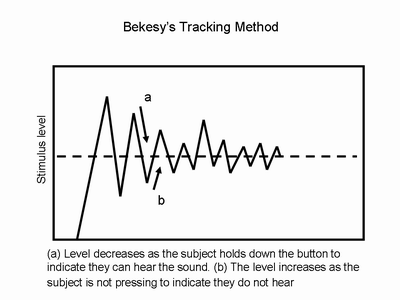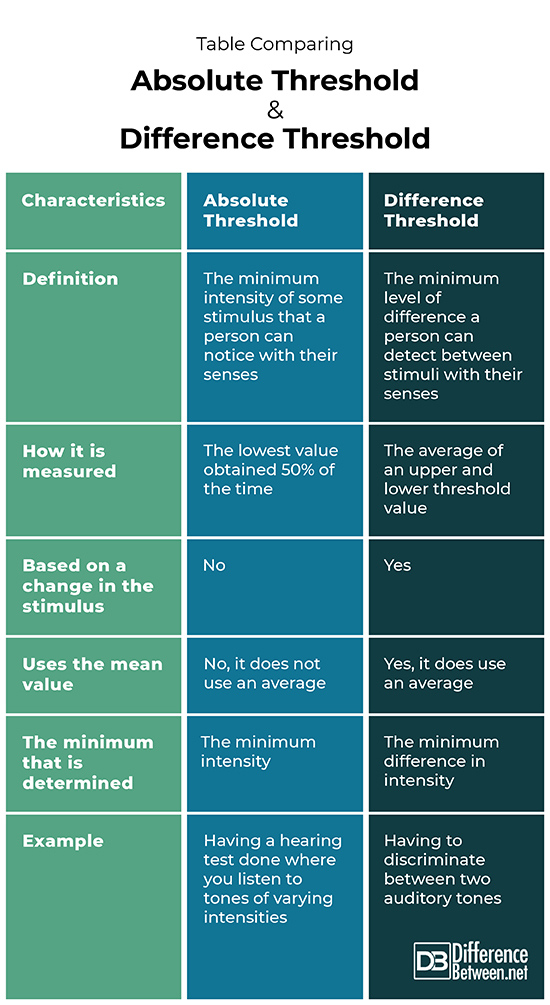Difference Between Absolute Threshold and Difference Threshold
An absolute threshold is the lowest intensity of a stimulus that a person notices at least 50% of the time. A difference threshold is the least difference between two stimuli that a person can notice.
What is Absolute Threshold?
Definition:
The absolute threshold is the minimum intensity of some stimulus that a person can notice with their senses. It is defined by Ernst Weber as the minimum or lowest intensity that a person will detect on at least half the trials in a test of the senses.
How it is measured:
A person is exposed to a stimulus at varying intensities and then asked to state if they can detect the stimulus or not in each case. The lowest or minimum intensity that a person can detect at least 50% of the time is then the absolute threshold value. The exact methods of the trials vary depending on which sense is being used and tested, for instance, taste versus vision. If taste is being tested then obviously the individual will have to taste some substance at varying strengths or intensities. If a person is having the vision measured then, for example, a candle will be held at different distances and the absolute threshold determined.
Examples:
An example that illustrates an absolute threshold is when a person goes has a hearing test done. An individual has to listen for the tones which are of different intensities. This threshold is likely to change as a person becomes older since there is likely to be age-related hearing loss. This is true for most of our senses which means that the actual value of the absolute threshold for each sense can change and is not the same for every person. Absolute intensity can also be used when assessing the fitness of individuals and for comparing the fitness of different groups of people.
Application:
Knowing the absolute threshold can be very useful even for the development of certain food items. For instance, establishing the level as an indicator of the pungency of chili was suggested as a good way to know how much should be added to a food dish in order for customers to detect the taste of the chili.
What is Difference Threshold?
Definition:
The difference threshold is based on how different the intensity of separate stimuli has to be in order for a person to notice that they are different. The value is often based on both a lower and an upper value. It is also referred to as the just noticeable difference (jnd), a term coined by the scientist Gustav Fechner a few decades after Weber came up with the concept of a difference threshold.
How it is measured:
It is often measured as an upper and a lower value, with the upper being the difference between intensity and ¾ of all trials. A lower threshold is the difference between what is perceived and 1/4 of the total number of trials. Usually, the difference threshold is calculated as an average value of these two difference threshold values. The idea of difference threshold led to the development of a specific formula by Weber, which is delta I/I = k. The values are k = a constant, I = initial or starting intensity and delta I is the difference threshold value. Rearranging the formula we can then determine distance threshold which is delta I. Delta I = k multiplied by I. The Weber constant is also known as the Weber fraction. An example of what the fraction means is for instance if k =0.02 then it means that people can detect a 2% change in the intensity of a particular stimulus. Weber’s law assumes that the change is by a constant amount which is described by the fraction or constant.
Examples:
An example of a difference threshold is having the ability to discriminate between two auditory tones that are being heard.
Application:
Determining the difference threshold is useful for marketers so that they can find the most cost-effective method of improving their products, for instance, changing packaging just enough to make a product more attractive but not so much that the profit margin drops for the company.
Difference between Absolute threshold and Difference threshold?
-
Definition
An absolute threshold is the minimum level of intensity of a particular stimulus that a person can notice with their senses. A difference threshold is the minimum or least difference between stimuli that a person can notice.
-
How it is measured
The way absolute threshold is measured is that the lowest intensity noticed 50% of the time by a person is recorded. The way the difference threshold is measured is that an upper and a lower threshold are measured and the average of the two values is taken.
-
Based on a change in the stimulus
The absolute threshold is not a value based on a person noticing and recording a change of a stimulus. The difference threshold is based on noticing a change in the stimulus and noticing the smallest change.
-
Uses the mean value
The mean value is not used when measuring the absolute threshold. The mean value is used when measuring the distance threshold.
-
The minimum that is determined
The absolute threshold is the minimum intensity that is recorded. The distance threshold is the minimum difference between the intensities that is recorded.
-
Example
An example of an absolute threshold is when a person has a hearing test and hears sound of different intensities. An example of a difference threshold is when a person is asked to discriminate between two auditory tones.
Table Comparing Absolute Threshold and Difference Threshold
Summary of Absolute Threshold Vs. Difference Threshold
- The absolute and difference threshold are both ways to see how a person’s senses are working.
- An absolute threshold is based on the lowest intensity of a stimulus that a person can detect at least half of the time.
- A difference threshold is based on the minimum or lowest difference among intensities of a stimulus that a person can detect.
- Difference Between Rumination and Regurgitation - June 13, 2024
- Difference Between Pyelectasis and Hydronephrosis - June 4, 2024
- Difference Between Cellulitis and Erysipelas - June 1, 2024
Search DifferenceBetween.net :
Leave a Response
References :
[0]Bruce Abbott. “Sensation and perception”. Thresholds. Indiana University – Purdue University Fort Wayne, 2012, http://users.ipfw.edu/abbott/120/thresholds.html
[1]Orellana‐Escobedo, L., et al. "Determination of absolute threshold and just noticeable difference in the sensory perception of pungency." Journal of food science 77.3 (2012): S135-S139.
[2]Ronald Sahyouni.” Webers law and thresholds.” Khan Academy, 2019, https://www.khanacademy.org/test-prep/mcat/processing-the-environment/sensory-perception/v/webers-law-and-thresholds
[3]Image credit: https://en.wikipedia.org/wiki/Absolute_threshold_of_hearing#/media/File:Bekesy's_Tracking_Method.png
[4]Image credit: https://commons.wikimedia.org/wiki/File:Negative_Feedback.jpg



